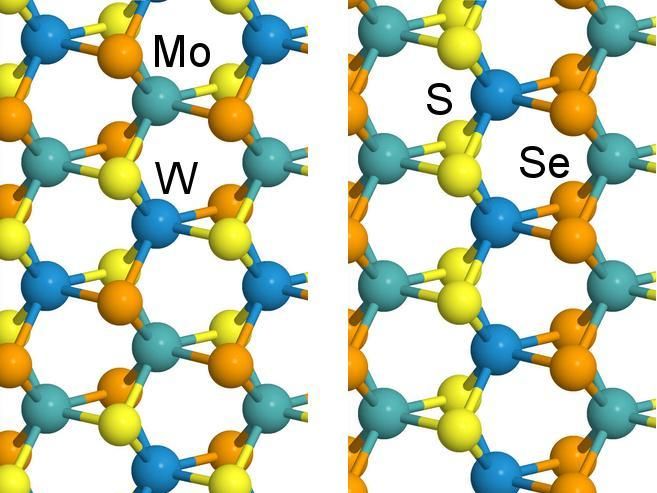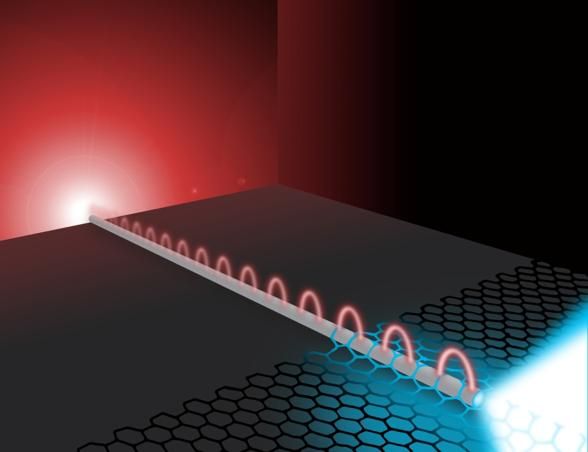Graphene foam detects explosives, emissions better than today's gas sensors
Rensselaer Polytechnic Institute engineering researchers overcome decade-old hurdle hampering development of nanostructure-based gas sensors
A new study from Rensselaer Polytechnic Institute demonstrates how graphene foam can outperform leading commercial gas sensors in detecting potentially dangerous and explosive chemicals. The discovery opens the door for a new generation of gas sensors to be used by bomb squads, law enforcement officials, defense organizations, and in various industrial settings.
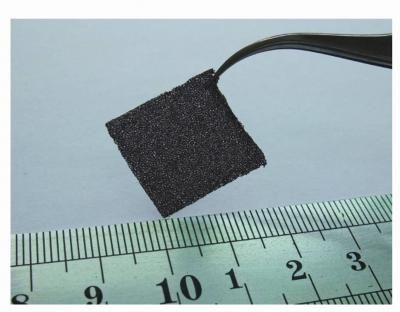
A new study from Rensselaer Polytechnic Institute demonstrates how graphene foam, as see here, can outperform leading commercial gas sensors in detecting potentially dangerous and explosive chemicals. The discovery opens the door for a new generation of gas sensors to be used by bomb squads, law enforcement officials, defense organizations, and in various industrial settings.
Rensselaer/Koratkar

A new study from Rensselaer Polytechnic Institute demonstrates how graphene foam, seen here in a scanning electron micrograph, can outperform leading commercial gas sensors in detecting potentially dangerous and explosive chemicals. The discovery opens the door for a new generation of gas sensors to be used by bomb squads, law enforcement officials, defense organizations, and in various industrial settings.
Rensselaer/Koratkar
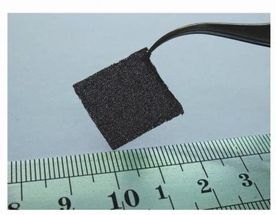
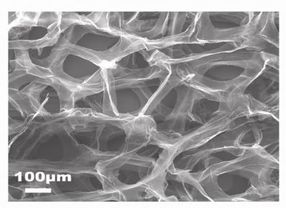
The new sensor successfully and repeatedly measured ammonia (NH3) and nitrogen dioxide (NO2) at concentrations as small as 20 parts-per-million. Made from continuous graphene nanosheets that grow into a foam-like structure about the size of a postage stamp and thickness of felt, the sensor is flexible, rugged, and finally overcomes the shortcomings that have prevented nanostructure-based gas detectors from reaching the marketplace.
Results of the study were released in the journal Scientific Reports, published by Nature Publishing Group.
"We are very excited about this new discovery, which we think could lead to new commercial gas sensors," said Rensselaer Engineering Professor Nikhil Koratkar, who co-led the study along with Professor Hui-Ming Cheng at the Shenyang National Laboratory for Materials Science at the Chinese Academy of Sciences. "So far, the sensors have shown to be significantly more sensitive at detecting ammonia and nitrogen dioxide at room temperature than the commercial gas detectors on the market today."
Over the past decade researchers have shown that individual nanostructures are extremely sensitive to chemicals and different gases. To build and operate a device using an individual nanostructure for gas detection, however, has proven to be far too complex, expensive, and unreliable to be commercially viable, Koratkar said. Such an endeavor would involve creating and manipulating the position of the individual nanostructure, locating it using microscopy, using lithography to apply gold contacts, followed by other slow, costly steps. Embedded within a handheld device, such a single nanostructure can be easily damaged and rendered inoperable. Additionally, it can be challenging to "clean" the detected gas from the single nanostructure.
The new postage stamp-sized structure developed by Koratkar has all of the same attractive properties as an individual nanostructure, but is much easier to work with because of its large, macroscale size. Koratkar's collaborators at the Chinese Academy of Sciences grew graphene on a structure of nickel foam. After removing the nickel foam, what's left is a large, free-standing network of foam-like graphene. Essentially a single layer of the graphite found commonly in our pencils or the charcoal we burn on our barbeques, graphene is an atom-thick sheet of carbon atoms arranged like a nanoscale chicken-wire fence. The walls of the foam-like graphene sensor are comprised of continuous graphene sheets without any physical breaks or interfaces between the sheets.
Koartkar and his students developed the idea to use this graphene foam structure as a gas detector. As a result of exposing the graphene foam to air contaminated with trace amounts of ammonia or nitrogen dioxide, the researchers found that the gas particles stuck, or adsorbed, to the foam's surface. This change in surface chemistry has a distinct impact upon the electrical resistance of the graphene. Measuring this change in resistance is the mechanism by which the sensor can detect different gases.
Additionally, the graphene foam gas detector is very convenient to clean. By applying a ~100 milliampere current through the graphene structure, Koratkar's team was able to heat the graphene foam enough to unattach, or desorb, all of the adsorbed gas particles. This cleaning mechanism has no impact on the graphene foam's ability to detect gases, which means the detection process is fully reversible and a device based on this new technology would be low power—no need for external heaters to clean the foam—and reusable.
Koratkar chose ammonia as a test gas to demonstrate the proof-of-concept for this new detector. Ammonium nitrate is present in many explosives and is known to gradually decompose and release trace amounts of ammonia. As a result, ammonia detectors are often used to test for the presence of an explosive. A toxic gas, ammonia also is used in a variety of industrial and medical processes, for which detectors are necessary to monitor for leaks.
Results of the study show the new graphene foam structure detected ammonia at 1,000 parts-per-million in 5 to 10 minutes at room temperature and atmospheric pressure. The accompanying change in the graphene's electrical resistance was about 30 percent. This compared favorably to commercially available conducting polymer sensors, which undergo a 30 percent resistance change in 5 to 10 minutes when exposed to 10,000 parts-per-million of ammonia. In the same time frame and with the same change in resistance, the graphene foam detector was 10 times as sensitive. The graphene foam detector's sensitivity is effective down to 20 parts-per-million, much lower than the commercially available devices. Additionally, many of the commercially available devices require high power consumption since they provide adequate sensitivity only at high temperatures, whereas the graphene foam detector operates at room temperature.
Koratkar's team used nitrogen dioxide as the second test gas. Different explosives including nitrocellulose gradually degrade, and are known to produce nitrogen dioxide gas as a byproduct. As a result, nitrogen dioxide also is used as a marker when testing for explosives. Additionally, nitrogen dioxide is a common pollutant found in combustion and auto emissions. Many different environmental monitoring systems feature real-time nitrogen dioxide detection.
The new graphene foam sensor detected nitrogen dioxide at 100 parts-per-million by a 10 percent resistance change in 5 to 10 minutes at room temperature and atmospheric pressure. It showed to be 10 times more sensitive than commercial conducting polymer sensors, which typically detect nitrogen dioxide at 1,000 part-per-million in the same time and with the same resistance chance at room temperature. Other nitrogen dioxide detectors available today require high power consumption and high temperatures to provide adequate sensitivity. The graphene foam sensor can detect nitrogen dioxide down to 20 parts-per-million at room temperature.
"We see this as the first practical nanostructure-based gas detector that's viable for commercialization," said Koratkar, a professor in the Department of Mechanical, Aerospace, and Nuclear Engineering at Rensselaer. "Our results show the graphene foam is able to detect ammonia and nitrogen dioxide at a concentration that is an order of magnitude lower than commercial gas detectors on the market today."
The graphene foam can be engineered to detect many different gases beyond ammonia and nitrogen dioxide, he said.
Studies have shown the electrical conductivity of an individual nanotube, nanowire, or graphene sheet is acutely sensitive to gas adsorbtion. But the small size of individual nanostructures made it costly and challenging to develop into a device, plus the structures are delicate and often don't yield consistent results.
The new graphene foam gas sensor overcomes these challenges. It is easy to handle and manipulate because of its large, macroscale size. The sensor also is flexible, rugged, and robust enough to handle wear and tear inside of a device. Plus it is fully reversible, and the results it provides are consistent and repeatable. Most important, the graphene foam is highly sensitive, thanks to its 3-D, porous structure that allows gases to easily adsorb to its huge surface area. Despite its large size, the graphene foam structure essentially functions as a single nanostructure. There are no breaks in the graphene network, which means there are no interfaces to overcome, and electrons flow freely with little resistance. This adds to the foam's sensitivity to gases.
"In a sense we have overcome the Achilles' heel of nanotechnology for chemical sensing," Koratkar said. "A single nanostructure works great, but doesn't mean much when applied in a real device in the real world. When you try to scale it up to macroscale proportions, the interfaces defeats what you're trying to accomplish, as the nanostructure's properties are dominated by interfaces. Now we're able to scale up graphene in a way that the interfaces are not present. This allows us to take advantage of the intrinsic properties of the nanostructure, yet work with a macroscopic structure that gives us repeatability, reliability, and robustness, but shows similar sensitivity to gas adsorbtion as a single nanostructure."
Original publication
Other news from the department science
These products might interest you
Most read news
More news from our other portals
See the theme worlds for related content
Topic world Sensor technology
Sensor technology has revolutionized the chemical industry by providing accurate, timely and reliable data across a wide range of processes. From monitoring critical parameters in production lines to early detection of potential malfunctions or hazards, sensors are the silent sentinels that ensure quality, efficiency and safety.

Topic world Sensor technology
Sensor technology has revolutionized the chemical industry by providing accurate, timely and reliable data across a wide range of processes. From monitoring critical parameters in production lines to early detection of potential malfunctions or hazards, sensors are the silent sentinels that ensure quality, efficiency and safety.


































































